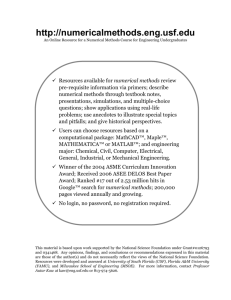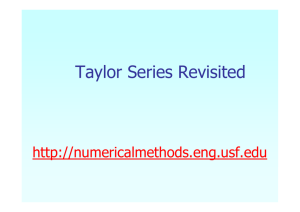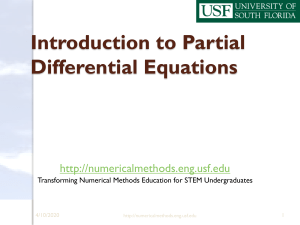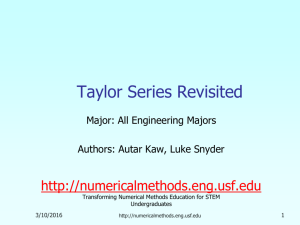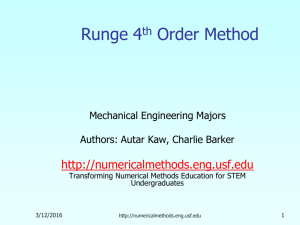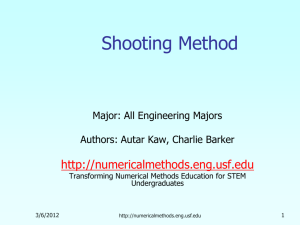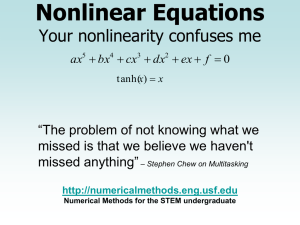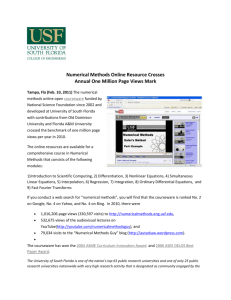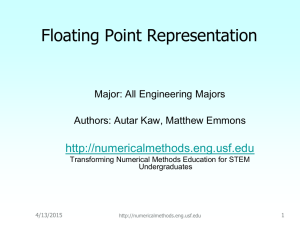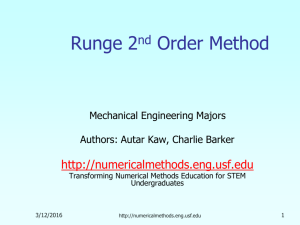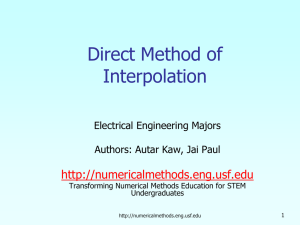Document
advertisement
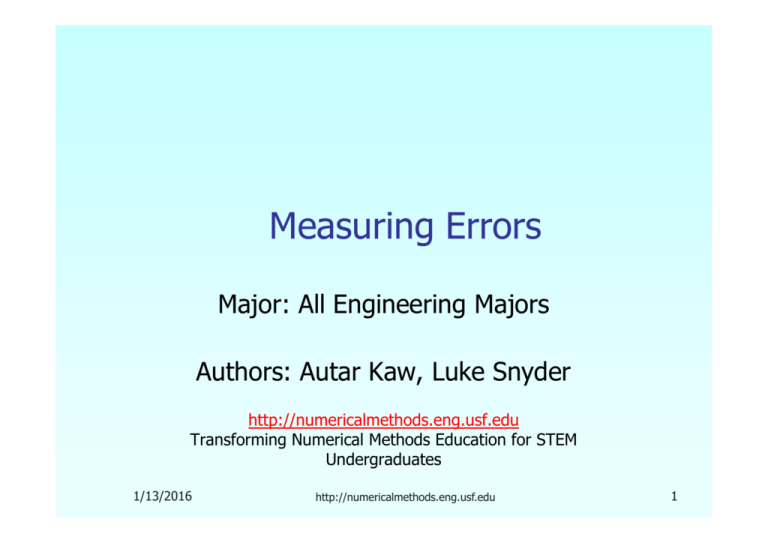
Measuring Errors Major: All Engineering Majors Authors: Autar Kaw, Luke Snyder http://numericalmethods.eng.usf.edu Transforming Numerical Methods Education for STEM Undergraduates 1/13/2016 http://numericalmethods.eng.usf.edu 1 Why measure errors? 1) To determine the accuracy of numerical results. 2) To develop stopping criteria for iterative algorithms. 2 http://numericalmethods.eng.usf.edu True Error Defined as the difference between the true value in a calculation and the approximate value found using a numerical method etc. True Error = True Value – Approximate Value 3 http://numericalmethods.eng.usf.edu Example—True Error The derivative, f ′(x) of a function f (x) can be approximated by the equation, f ' ( x) ≈ f ( x + h) − f ( x) h 0.5 x If f ( x) = 7e and h = 0.3 a) Find the approximate value of f ' ( 2) b) True value of f ' ( 2) c) True error for part (a) 4 http://numericalmethods.eng.usf.edu Example (cont.) Solution: a) For x = 2 and h = 0.3 f ( 2 + 0.3) − f ( 2) 0 .3 f ( 2.3) − f (2) = 0. 3 f ' ( 2) ≈ 7e 0.5( 2.3) − 7e 0.5( 2 ) = 0.3 22.107 − 19.028 = 10.263 = 0.3 5 http://numericalmethods.eng.usf.edu Example (cont.) Solution: b) The exact value of f ' ( 2) can be found by using our knowledge of differential calculus. f ( x ) = 7 e 0 .5 x f ' ( x ) = 7 × 0.5 × e 0.5 x = 3.5e 0.5 x So the true value of f ' ( 2) = 3.5e 0.5( 2 ) = 9.5140 f ' ( 2) is True error is calculated as Et = True Value – Approximate Value = 9.5140 − 10 .263 = −0.722 6 http://numericalmethods.eng.usf.edu Relative True Error Defined as the ratio between the true error, and the true value. Relative True Error ( ∈t ) = 7 True Error True Value http://numericalmethods.eng.usf.edu Example—Relative True Error Following from the previous example for true error, find the relative true error for f ( x) = 7e 0.5 x at f ' (2) with h = 0.3 From the previous example, Et = −0.722 Relative True Error is defined as True Error True Value − 0.722 = = −0.075888 9.5140 ∈t = as a percentage, ∈t = −0.075888 × 100% = −7.5888 % 8 http://numericalmethods.eng.usf.edu Table of Values 0.5 x For f ( x) = 7e at x = 2 with varying step size, h 9 h f ′(2) ∈a m 0.3 10.263 N/A 0 0.15 9.8800 3.877% 1 0.10 9.7558 1.273% 1 0.01 9.5378 2.285% 1 0.001 9.5164 0.2249% 2 http://numericalmethods.eng.usf.edu Example: Evaluate the following function at x=1.0002 using Maple 10-digit floating point arithmetic Naïve calculation: Find the Taylor polynomial of f(1+h) of degree 3: 10 http://numericalmethods.eng.usf.edu Error in yesterday’s slides: The remainder, for c between 1 and 1.0002 So the value is approximately 0.33330247 Confimation using 30-digit evaluation 11 http://numericalmethods.eng.usf.edu Evaluate by Desmos Direct: -3.3030859 Taylor polynomial : -3.0863781 http://numericalmethods.eng.usf.edu Taylor series by Symbolab 13 http://numericalmethods.eng.usf.edu Homework: 1. (Maple) For the function (i) (ii) (iii) (iv) (v) (vi) Evaluate f(2.01) directly in Maple Find the Taylor polynomial of f(2+h) of degree 5 Evaluate f(2.01) using the Taylor polynomial in (ii) Find the remainder Plot the remainder and estimate the error of Taylor polynomial Evaluate f(2.01) using 30-digit evaluation to confirm the value and error 2. For a function f(x), we know f(2.3) = 1.54, f’(2.3) = -3.21, f’’(2.3) = 0, f’’’(2.3) = 6.11 what are the values of f(2.3105) and f(2.2993) approximately? 3. (Maple) How to calculate f(0.524) for f(x) = accurately using 10-digit, knowing 14 http://numericalmethods.eng.usf.edu 4. (Symbolab and Desmos) For function compare direct evaluation of f(2.0003) with aylor polynomial of degree 4, then estimate the error by the remainder What is the error and relative error in each case? 15 http://numericalmethods.eng.usf.edu 16 http://numericalmethods.eng.usf.edu 17 http://numericalmethods.eng.usf.edu

